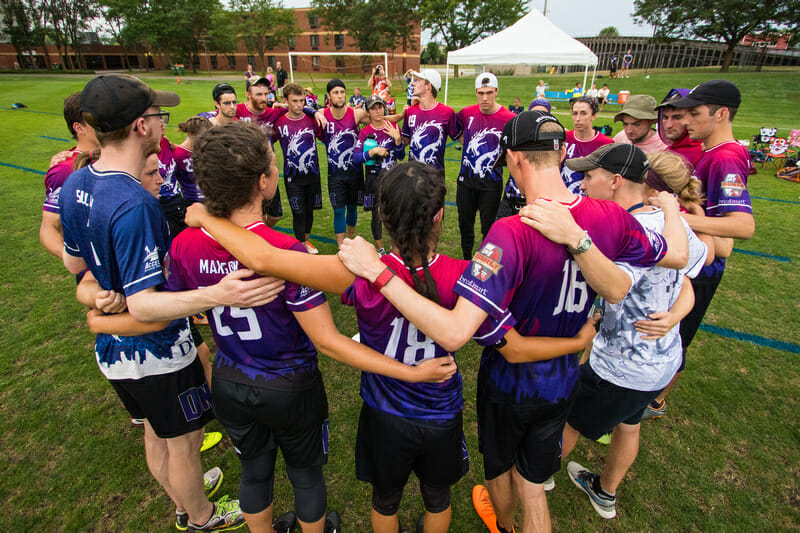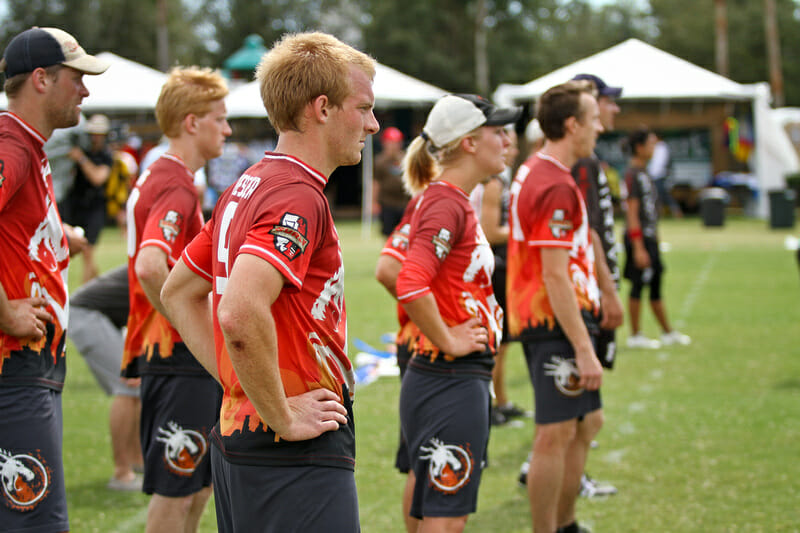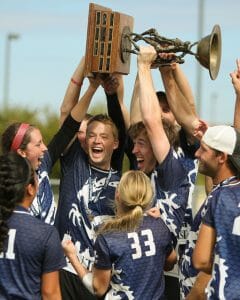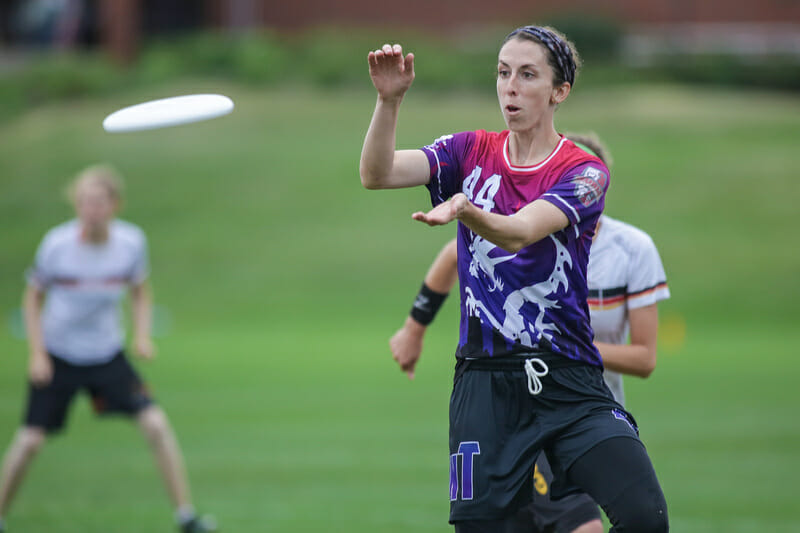Drag'N Thrust's legacy is already established, but they could do more.
October 17, 2018 by Graham Gerhart in Profile with 0 comments

Ultiworld’s reporting on the mixed division is presented by Universe Point cleats. All opinions are those of the authors. Please support the brands that make Ultiworld possible and shop at Universe Point!
At what point does an ultimate team become a dynasty? How many records need to be broken and games won before a team even enters the conversation? We’ve now had a full decade of Minneapolis Drag’N Thrust and they are in the midst of creating the most successful ten-year stretch from any mixed team, ever.
In the Mixed Division, no other team has won as many consecutive national titles as Drag’N Thrust (three, 2013-15). In fact, no other team has won as many titles as the Twin Cities powerhouse. After ten years as a program, Drag’n has qualified for nationals in every year but their first and made quarters or better in seven of those appearances1. The only other team with a similar pedigree is Boston Slow White, but even they fall short of Minnesota’s sustained excellence.
Drag’N Thrust’s continued success is an act of defiance. While many of their rivals have gone through natural rebuilding cycles, Drag’N has seemed to remain at the top of their game. Achieving such heights hasn’t been easy—the past ten years have offered their fair share of difficulties. And dealing with each problem has helped them become the team they are today.
2009: The Makings Of A Title Contender
While Minnesota has had a number of very successful ultimate programs over the years, it has never been considered a hub of club ultimate. Despite being home to Carleton, arguably the most prestigious college program in the country, Minnesota has had very little success at nationals. Apart from a single semis appearance by Sub Zero in 1999, no Minnesota club team had finished in the top four at nationals.2
This all changed with the inception of Alpha Cobra Squadron, a mixed team based out of Minneapolis. They made a deep run in the 2008 club season, falling just shy the national final. The team’s success that year was greatly encouraging for many players from the Twin Cities, but did have a prominent asterisk next to their accomplishments. Alpha Cobra Squadron was not exclusively from the North Star state. That year, Chad Larson Experience (CLX) and Flaming Moe–Drag’N Thrust’s predecessor–joined forces to make one immensely talented roster.
So when CLX decided to reform their Iowa-based club in 2009, the remaining players from Alpha Cobra Squadron felt it was their time to form a truly elite Minnesota-based mixed team. They had tasted true success at Nationals and were eager to return to that level quickly.
“I joined the team as a total newcomer to mixed ultimate, and was assured ‘this team will go deep at Nationals,'” said current Drag’N Thrust captain Austin Lien.
Unfortunately, Drag’n Thrust didn’t quite meet those expectations in 2009. The team had managed to entice generational talents like Robyn Wiseman, Austin Lien, Jake Henderson, and Jamie Glader to join their ranks but struggled in the postseason and ultimately missed out on even making Nationals.
For Lien, the cause of their problems was fairly evident in the team’s first season. “We only had three formal practices that year,” he said. “We did not end up qualifying, of course, which ended up being a huge motivation for the following years.”
2010-2012: Enter The Drag’N

Falling short of their first season’s goals was disappointing, but it spurred the new team into action.
Drag’N started having regular practices and recruited more high-level talent, including Jeff Trosvig and Martha Lien. The team no longer wanted to frame themselves as a pickup team. They had seen how far that could take them and knew they wanted to go further. While they did want to retain the camaraderie that they established in 2009, there was a drive to develop as a team and be a threat on the elite level. It was this understanding that helped them build an identity around hard work and competitive edge.
Over the course of the next three years, they would prove both their work ethic and their ability to match up against the best teams in the nation. In 2010, the team scorched the regular season, ending it with a 19-3 record. Their Trogdor-inspired rampage continued in the postseason, where they beat CLX to end Sectionals and Regionals with a perfect record.
As luck would have it, Drag’N and CLX met again at Nationals and this time the veteran Iowan squad came away with the victory. The loss was disheartening for the team, and a real setback, but they rallied around their worker mentality and dug deep during power pools. Their grit got them all the way to semis, where they eventually lost to former Connecticut team District 5. The team hadn’t made the finals but now knew they had what it took to take on the best teams in the nation.
With their newfound confidence, Drag’N started 2011 on a high note but quickly fell down to earth soon after. At the Philly Invite, Drag’N suffered three consecutive losses to start their season. They found consistency in the rest of the regular season, but still struggled against their neighboring nemesis CLX. Despite Drag’N ending the regular season with a 2-1 lead in their head-to-head battles, every game was closely contested. The 2011 postseason was no different. CLX came away with a pivotal win in the Regional finals and it placed Drag’N in a tough pool for Nationals. Losing to both Philadelphia AMP and District 5 was enough to knock the Minnesotans out of the power pools and the team never recovered.
After such a promising 2010 season, their lower finish in 2011 was particularly discouraging. But just as they had done in the past, the core of the team used it as motivation and Drag’N stormed into 2012 with some fresh faces on the roster and renewed vigor. All their new firepower–including budding superstar Sarah Meckstroth–helped the team earn some decisive wins and finish the regular season with a 17-5 record. Their record was promising, but most of their losses came at the hands of the teams they would need to beat at Nationals if they wanted to make the bracket again. That was in the back of everyone’s mind as they entered the postseason.
“The Mixed Division had gained more notoriety, and a greater number of talented players chose to make their homes here,” said Austin Lien. “The changes in the sport itself were a driving factor for us to adapt.”
So Drag’N Thrust put their heads down and worked on being the best team that they could be, focusing inward, rather than outward. But even as Drag’N was improving, so was their competition.
This included CLX, whom Drag’N had played three times in the regular season, again ending it with a 2-1 edge over the Iowans. Just as it had been for the past two years, the teams met in the Regionals finals to play, and once again, Drag’N Thrust fell short. “CLX was a dominant team for a long time and seemed to always have our number in the early years,” said the Drag’N captains. “We were friendly off the field but always very fiery towards each other in-game.”
Luckily, at the 2012 Nationals in Sarasota, the two teams avoided meeting, as both entered bracket play with a perfect 6-0 record. It seemed as if they were destined to meet once more, but an uncharacteristic CLX loss to Mischief knocked them out in quarters. Drag’N proceeded to semis, where they promptly lost to Brian Garcia and the surging Blackbird team that was headed for their second straight national title.
Drag’N had finished 3rd in the nation once more.
2013-2015: The Reign Of The Drag’N

When 2013 started, Drag’N Thrust knew they needed a change. They had the talent for a deep run into the bracket, but hadn’t figured out how to take the extra step to make the finals. The difference-maker for them came in the form of coach Jake Henderson.
“Jake was key in the vision the team had, knowing how to build the program and grow instead of trading it all for a win now mentality,” said current Drag’N coach John Groess. This patient program-building attitude paid off for Drag’N in the long run. Despite having their worst regular season record since 2009 (13-6), the team still seemed poised for another deep run at Nationals. It helped that they had added players like Brian Schoenrock and Jay Drescher to bolster an already formidable roster.
At Nationals, Minnesota had a chance to show off what they had been working towards all season. No game was a blowout, but Drag’N lit up their competition. Even in their closest games, the Minnesotans always looked confident and in control. Eventually, after a tight battle with the Polar Bears, Minneapolis earned the first club championship their city and state had ever claimed. The Drag’N Thrust players were quick to praise Henderson for his role at that tournament. “The mentality, toughness (as both players and mental toughness), and spirit as a group is in large part due to his leadership and steering,” said the captains.
One national title wasn’t enough for Minnesota, though. With Henderson stewarding one of the most intimidating offensive units in the division, Drag’N took home two more consecutive national titles. They ended 2014 with a regular season record of 9-4, before sweeping the postseason. Then, in 2015, they went 14-1 in the regular season3, battled back from a pool play loss to Mixtape at Nationals, and beat Seattle in the final when it counted.
For Austin Lien, a lot of their success came from roster construction. “In order to adapt in games, we have filled skill roles very specifically,” he said. “We’ll build a roster one season with the expectation that we’ll continue growing into it over the next.”
And the success of the Twin Cities squad was mainly due to their system that plugged different players into specific roles. Drag’N always had skilled throwers in the backfield looking for big athletes headed deep. They simplified their vertical stack to streamline these plays, and often won games off a few pivotal hucks that broke the confidence of their opponent’s defense.
Injuries didn’t seem to slow down the team during this time, either. Drag’N had their own fair share of inactive players during this stretch but were bolstered by a legion of formidable role players. Athletes like Pat Niles, Josh Hemmesch, Erica Baken, and Claire Oakley were always ready to step up when needed, even if they were sometimes overshadowed by Drag’N Thrust’s more prolific stars.
2016-2017: The Descent Of Drag’N
The fact that 2016 and 2017 were seen as down years for Drag’N Thrust is a testament to the legend that the team created after winning three consecutive titles.
The Minneapolis team had a bumpy regular season in 2016 but their talent still shone through when it mattered. At Nationals, they went unchallenged in pool play and destroyed Mixtape in quarters. If not for Boston Slow White’s unassailable offense, Drag’N had a clear line to the finals. They may not have claimed a fourth title, but semis was a respectable finish.
2017 was the first time that Drag’N Thrust showed any sign of slowing. They finished the regular season with a 12-7 record and barely made it out of pool play after a surprise loss to shame. In bracket play, they were vanquished again by Slow White and had to go back to the drawing board. A quarterfinals exit was their lowest finish in six years.
But just as before, Drag’N channeled their disappointment into resolve.
2018 Onwards: A Drag’N Reborn

Minneapolis made a lot of changes ahead of the 2018 season. First, they had to deal with a large amount of roster turnover. Stalwarts like Jake McKean, Jay Drescher, David Shirley, Jess Haller, and Jeff Trosvig are all gone4. Many of these players had helped define Drag’n Thrust over the past five years of the team’s existence. Drag’N’s leadership was the first to admit that this presented an immediate challenge to them this year.
“In terms of talent and time spent on the team, there is a significant chunk missing from last season,” said Austin Lien.
In their place, Drag’n added some explosive new players, including Caleb Denecour, Tavis Leighton, and Blake Trantina. These players were immediately asked to shoulder a heavy load on both offense and defense. Drag’N was used to having veteran talent to fill the roles that they had created in their offense and now was looking to rookies that were unproven in their system.
It wasn’t just players that were new to the team, either. Jake Henderson stepped down in 2017 and the Drag’N leadership brought in Groess to take his place. Unlike Henderson, Groess had never played with the team before and there was some concern that he would not be as familiar with their style and system. These adjustments were enough to spark some speculation that Drag’N had finally hit their rebuilding years, and after nine full years was maybe was slowing down in their old age.
And yet, despite the evidence seemingly stacked against them, Drag’N has put together one of their strongest seasons yet. The Twin Cities team is heading to San Diego as the second overall seed and ended the regular season with a 20-3 record. When asked about their recent success, Austin Lien was quick to point it back to Groess.
“We recognized that him entering this role as an outsider to the team would be a challenge, and he has embraced and far overcome it,” Lien said.
Groess has helped recenter Drag’N Thrust’s offense. The team has moved away from their vertical stack and now relies on a more horizontal offense. They have also turned away from their run and gun reputation after a defensive stop. Losing Drescher and Trosvig may have contributed to their change in style, but it is also clearly a strategy that the entire team has adopted.
The team has also adapted to their opponents over the past few seasons. As new teams arise and tactics evolve within the Division, Drag’N has worked hard to keep up. “More film is available, so we find ourselves working deeper into our own strategic rotations and scouting other teams closely,” said Austin Lien.
With Nationals looming, Drag’N Thrust has started to focus on particular matchups, predicting the teams that they will play. As Austin Lien tells it, setting their sites on the title involves preparing for the right teams: “When it comes down to it, the champion will have to beat a few of the top five teams in the country, regardless of when that happens in the tournament.”
In their 10 seasons as a team, Drag’N has reached the pinnacle of the sport three times, and now, as they prepare to make another run towards a championship, the captains are still willing to look beyond the tournament in front of them.
Drag’N Thrust isn’t only the roster that is competing in the 2018 season, the team is where it is because of all the players that came before them, and all the players that will come after.
“I would love if our team’s reputation far outshone those of the individual players. A great number of different people have contributed to our successes,” said Austin Lien. “Ten years from now, when a new player puts on a Drag’N Thrust jersey for the first time, I hope they are still excited for the opportunities that are about to come their way.”